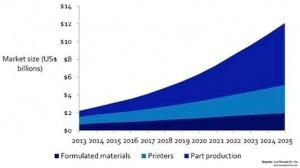Whether experimenting, prototyping, or producing final products, manufacturers are jumping ever faster into the world of 3D printing. By 2013, more leading manufacturing companies than not were using 3D printing technologies.
Over the next decade, Lux Research expects the global 3D printing market to quadruple to $12 billion, with $7 billion of that attributed to printed products. More and more companies will move from experiments and prototypes to printing finished products as 3D printing expands its presence.
In fact, manufacturing will nearly quadruple its share of the total 3D printing market, accounting for a projected 46% in 2025. (Most of the rest of the market will be made up of printer sales and demand for the thermo polymers and other materials used in the printing process.)
As manufacturing continues to grow as a share of applications, more companies will adapt and expand their uses of 3D printing technology.
PricewaterhouseCooper (PWC) conducted a survey of over 100 leading manufacturing companies. Two-thirds of these top firms already utilize 3D printing, in applications ranging from experimenting to only prototyping to companies using 3D printing for both prototyping and production.
Still representing small percentages, some companies build products via 3D printing that are unable to be constructed using traditional methods, while others use it for final products or parts. While these applications represented only 3% and 1%, respectively, of the surveyed manufacturers, these niche producers are on the cutting edge of technology.
Among the major manufacturers currently using 3D printing is Ford Motor Company. 200,000 parts are printed each year on 14 different industrial 3D printers at Ford’s Dearborn Heights, Michigan facility. That facility is only one of Ford’s five 3D prototyping centers – one of three in the US.
While Ford has been involved with 3D printing since the 1980s – in 1988, the company purchased the third 3D printer ever made – new uses will continue to emerge. Some examples of Ford’s recent uses of 3D sand printing are:
- Rotor supports, transmission cases, damper housings, and end covers for new HF35 hybrid transmission for C-MAX Hybrid and Fusion Hybrid
- Four-cylinder EcoBoost engines for Fusion
- Brake rotors for Explorer (modified in development using 3D printing)
- Exhaust manifolds for 3.5-liter EcoBoost in F-150
Ford’s 500,000th 3D printed auto part was a prototype engine cover for the Mustang. While so far Ford has focused on prototypes printed in plastic, the company is looking to the future of its 3D printing strategy, when final production parts may be printed in metal.
Generally, 3D printing utilizes a process that can save any manufacturer time and money in prototyping and, eventually, in end-use product creation. Because 3D printing uses an “additive manufacturing” process, in which the product is added to (rather than the traditional “subtractive manufacturing” process involved in lathing machine parts), waste materials drop from 90% to only 5-10%. The significant drop in waste materials represents a savvier way to manufacture, adding an eco-friendly feature saving on total waste.
While in the immediate future, 3D printing still has some pretty hefty roadblocks ahead of it – high costs, time-consuming print jobs, and inability to mix materials in a single print job chief among them – trends in technology are favorable for the adoption of 3D printing in more final product usage. PWC noted in its survey that an emerging mid-level class of 3D printers will offer features higher-end systems used, as well as the fact that the control of many key patents are approaching expiry, which tends to expedite innovation among a broader base of manufacturers.
Companies as diverse as General Electric, Invisalign, and Airbus will all eventually benefit from 3D printing’s expansion. As more complex parts can be printed, final products ranging from clear dental braces to, eventually, a completely 3D printed airplane will emerge.
Did you realize the impact that 3D printing is already making on manufacturing? Discuss with us in the 3D Printing and Manufacturing forum thread on 3DP.com.
Subscribe to Our Email Newsletter
Stay up-to-date on all the latest news from the 3D printing industry and receive information and offers from third party vendors.
You May Also Like
Why Corrosive Resistant Materials Are Important to the Success of 3D Printing Across Industries
The adoption of additive manufacturing (AM) is accelerating across many major industries. As this technological shift unfolds, the importance of corrosion resistance has emerged as a challenge for 3D printing...
America Makes Announces IMPACT 2.0: $6.6M in New 3D Printing Funding
America Makes, the Manufacturing Innovation Institute (MII) based in Youngstown, Ohio, has announced IMPACT (Improvement in Manufacturing Productivity via Additive Capabilities and Techno-Economic Analysis) 2.0, a project call which will...
3D Printing Webinar and Event Roundup: April 14, 2024
We’re starting off the week’s 3D printing webinars and events at ASTM AMCOE’s 11th Snapshot Workshop and MACH Exhibition. Stratasys continues its advanced training courses, SME is holding a virtual...
AMUK Welcomes Airframe Designs as British 3D Printing Industry Grows
While the UK is not the hub for 3D printer and materials manufacturers as other nations, the country continues to excel at the research, development, and application of additive manufacturing...


































